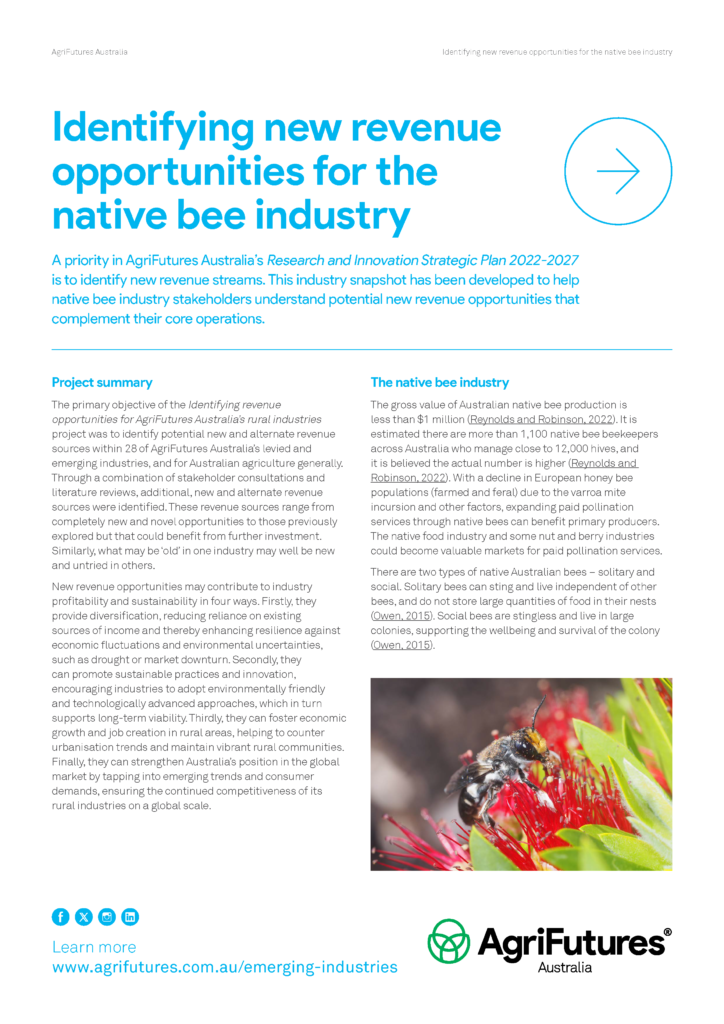The primary objective of the Identifying revenue opportunities for AgriFutures Australia’s rural industries project was to identify potential new and alternate revenue sources within 28 of AgriFutures Australia’s levied and emerging industries, and for Australian agriculture generally. Through a combination of stakeholder consultations and literature reviews, additional, new and alternate revenue sources were identified. These revenue sources range from completely new and novel opportunities to those previously explored but that could benefit from further investment. Similarly, what may be ‘old’ in one industry may well be new and untried in others.
New revenue opportunities may contribute to industry profitability and sustainability in four ways. Firstly, they provide diversification, reducing reliance on existing sources of income and thereby enhancing resilience against economic fluctuations and environmental uncertainties, such as drought or market downturn. Secondly, they can promote sustainable practices and innovation, encouraging industries to adopt environmentally friendly and technologically advanced approaches, which in turn supports long-term viability. Thirdly, they can foster economic growth and job creation in rural areas, helping to counter urbanisation trends and maintain vibrant rural communities. Finally, they can strengthen Australia’s position in the global market by tapping into emerging trends and consumer demands, ensuring the continued competitiveness of its rural industries on a global scale.
Industry-specific challenges
Specific insights relating to the Australian native bee industry include:
1. Stingless bees are only active in summer or warm weather, unlike honey bees, which are active even in cooler conditions. While this means that year-round availability of honey and potential pollination services is a challenge, there is opportunity to build the industry in warmer northern Australian regions where stingless bees are found.
2. The volume of honey produced by native bees is significantly smaller compared to that produced by honey bees due to hive colony size and the impact of climate. This challenge is mitigated by the premium price native bee honey can be sold for.
3. The honey from native bees does not fall within some official definitions of honey and is referred to as ‘sugarbag’, which may include honey or a mix of pollen and honey. Its appeal, however, lies in its high concentration of the sugar trehalulose, its higher moisture content and its lower sugar content.
Industry-specific opportunities
Specific opportunities relating to the Australian native bee industry include:
1. Investment in the development of the pollination services sector – articulating and spreading the word about the complementarity of the pollination capabilities of native bees, including specialist applications, backed by further research could help establish paid native bee pollination services. Doing so could address the decline in pollination by honey bees.
2. Promotion of the health benefits of native bee honey (sugarbag) through evidence-based research and marketing efforts. Also, differentiating native bee honey from honey bee honey and promoting it as a niche ‘superfood’ that can command a premium price.
3. Hive by-products, including beeswax, pollen and propolis, offer additional revenue streams for beekeepers and value chain stakeholders. Products could cater to various industries, including those that produce cosmetics, nutraceuticals, pharmaceuticals and dietary supplements, contributing to the industry’s growth and diversification. Native bee tourism, especially in tourism hotspots, also presents a niche market that indirectly promotes native bee honey.





